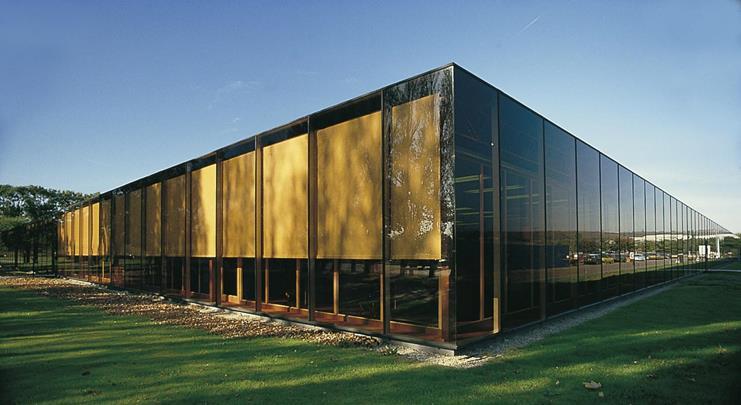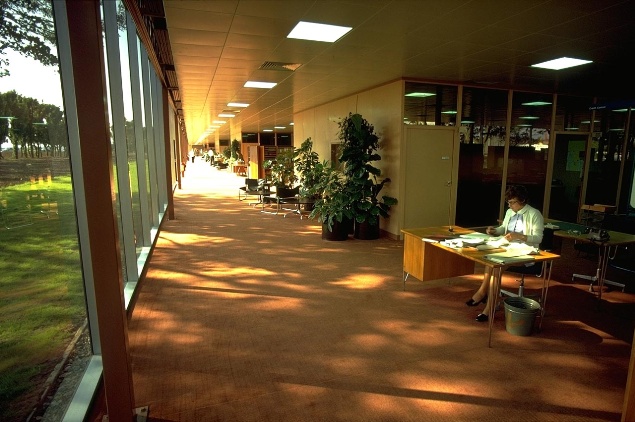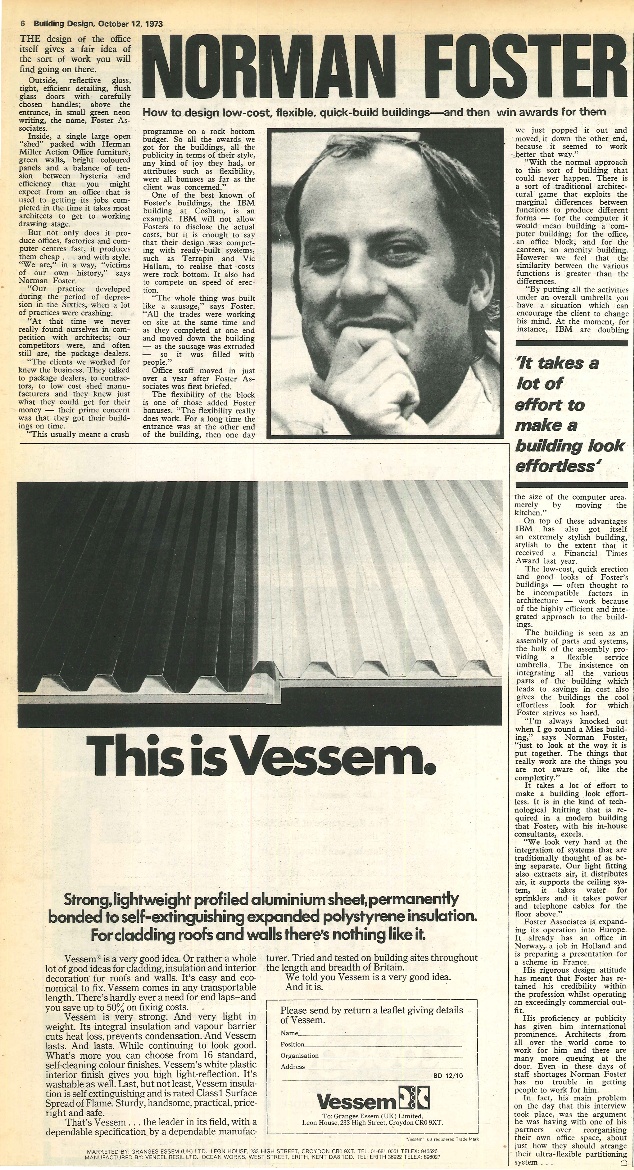Submitted by WA Contents
Norman Foster in 1973: Low-cost, quick and good looking
United Kingdom Architecture News - Nov 29, 2013 - 21:38 9783 views

In the first of a new archive series, BD looks back at some of the most interesting features from our pages 40 years ago.
A lot has changed for Norman Foster since 1973 — not least the idea that he produces ‘cheap’ architecture. Back then, Foster Associates was just starting to expand into Europe. But some things do stay the same — like Foster’s ability to produce commercial work but retain credibility and proficiency for publicity.
Norman Foster: How to design low-cost, flexible, quick-build buildings — and then win awards for them
The design of the office itself gives a fair idea of the sort of work you will find going on there.
Outside, reflective glass, tight efficient detailing, flush glass doors with carefully chosen handles; above the entrance, in small, green neon writing, the name, Foster Associates.
Inside, single large open “shed” packed with Herman Miller Action Office furniture, green walls, bright coloured panels and a balance of tension between hysteria and efficiency that you might expect from an office that is used to getting its jobs completed in the time that it takes most architects to get to the working drawing stage.
But not only does it produce offices, factories and computer centres fast, it produces them cheap… and with style. We are, in a way “victims of our own history” says Norman Foster.

Norman Foster, 1973
“Our practice developed during the period of depression in the sixties, when a lot of practices were crashing.
“At that time we never really found ourselves in competition with architects; our competitors were, and still are, the package dealers.
“The clients we worked for knew the business. They talked to package dealers, to contractors, to low-cost shed manufacturers and they knew just what they could get for their money — their prime concern was that they got their buildings on time.
“This usually meant a crash program on a rock-bottom budget. So all the awards we got for buildings, all the publicity in terms of their style, any kind of joy they had, or attributes such as flexibility, were all bonuses as far as the client was concerned.”
One of the best known of Foster’s buildings, the IBM building at Cosham, is an example. IBM will not allow Fosters to disclose the actual costs, but it is enough to say that their design was competing with ready-built systems such as Terrapin and Vic Hallam, to realise that costs were rock bottom. It also had to compete on speed of erection.
“The whole thing was built like a sausage,” says Foster. “All the trades were working on site at the same time and as they completed at one end and end moved down the building— so the sausage was extruded — so it was filled with people.”
Office staff moved in just over a year after Foster Associates was first briefed.
The flexibility of the block is one of those added bonuses. “The flexibility really does work. For a long time the entrance was at the other end of the building, then one day we just popped it out and moved it down the other end, because it seemed to work better that way.”
“With the normal approach to this sort of building that could never happen. There is a sort of traditional architectural game that exploits the marginal differences between functions to produce different forms — for the computer it would mean building a computer building; for the office, an office block; and for the canteen, an amenity building. However we feel that the similarity between the various functions is greater than the differences.
“By putting all the activities under an overall umbrella you have a situation which can encourage the client to change his mind. At the moment, for instance, IBM are doubling the size of the computer area merely by moving the kitchen.”
On top of these advantages IBM has also got itself an extremely stylish building, stylish to the extent that it received a Financial Times Award last year (1972).

Source: Foster & Partners//IBM Pilot Head Office, Cosham by Foster and Partners
The low-cost, quick erection and good looks of Foster’s building — often thought to be incompatible factors in architecture — work because of the highly efficient and integrated approach to the buildings.
The building is seen as an assembly of parts and systems, the bulk of the assembly providing a flexible service umbrella. The insistence of integrating all the various parts of the building which leads to savings in costs also gives the buildings the cool and effortless look for which Foster strives so hard.
“I’m always knocked out when I go around a Mies building,” says Norman Foster, “just to look at the way it is put together. The things that really work are the things you are not aware of, like the complexity.”
It takes a lot of effort to make the building look effortless. It is the kind of technological knitting that is required in a modern building that Foster, with his in-house consultants, excels.
“We look very hard at the integration of systems that are traditionally thought of as being separate. A light fitting also extracts air, it distributes air, it supports the ceiling system, it takes water for the sprinklers and it takes power and telephone cables for the floor above.”
''It takes a lot of effort to make a building look effortless''
Foster Associates is expanding its operation into Europe. It already has an office in Norway, a job in Holland and is preparing a presentation for a scheme in France.
His rigorous design attitude has meant that Foster has retained his credibility within the profession whilst operating an exceedingly commercial outfit.
His proficiency at publicity has given him international prominence. Architects from all over the world come to work for him and there are many more queueing at the door. Even in these days of staff shortages Norman Foster has no trouble in getting people to work for him.
In fact, his main problem on the day that this interview took place, was the argument he was having with one of his partners over reorganising their own office space, about how they should arrange their ultra-flexible partitioning system…

> via bdonline.co.uk
